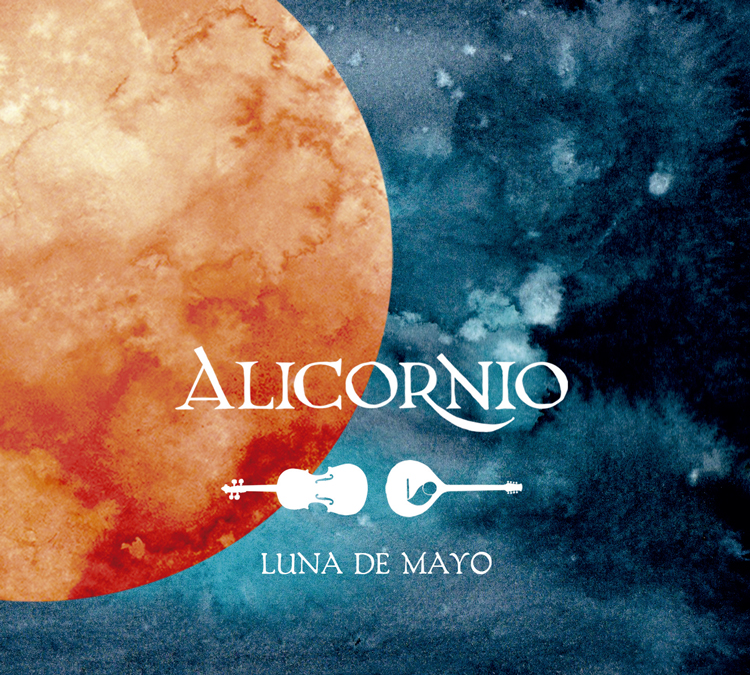Alicornio – Luna de mayo (Alicornio, 2023)
“Luna de mayo” presents the superb contemporary folk music of Alicornio, a talented duo from Valladolid (Castilla y León, Spain). The two musicians, joined by friends, have recreated traditional folk songs and tunes from Valladolid and nearby provinces, giving them new life, featuring finely crafted, timeless arrangements skillfully performed with a mix of native Spanish musical instruments as well as recent introductions like the Greek bouzouki that has become popular among folk musicians throughout Western Europe.
Alicornio includes Águeda Sastre Zamora and Carlos Martín Aires. “Luna de mayo”, the group’s second album, was recorded in their own studio throughout 2022.
“Luna de mayo” is the result of several years of work on traditional songs from the province of Valladolid, adapted to vocals, the violin and bouzouki. “For the most part, they are songs that we have learned from recordings in the Archive of the Joaquín Díaz Foundation, although there are other sources as well.”
Unlike Alicornio’s previous album, “Sol de los soles”, the duo opened up a little more to music from other provinces in the interior of the Iberian Peninsula (Zamora, Segovia, Palencia), although the majority are still songs from Valladolid. “We have also introduced some other instruments, such as the tambourine, the baritone violin, the mandolin and the bagpipe.”
Alicornio describes the songs and medleys featured on the albums:
La Forosa
The first of these dances is an asentao played by the dulzainero (dulzaina player) Pedro Inaraja, “Puja”, from La Pedraja de Portillo, and which came down to us thanks to the recordings that Gerardo Soba made of Félix Inaraja, drummer and great dancer, son of Pedro. We finished off with “La Forosa”, a fandango sung by Erenia Guerra and señora Pascuala, from Villabrágima.
Pelitos De Ratón (Mouse Hairs)
This fandango was sung by Amalia Gómez, from La Overuela. We have been playing it among ourselves for many years, and we decided to compose an instrumental part and record it on this album.
Habas de Patapalo (Patapalo Habas)
Isidoro Arranz, known as “Patapalo”, was a dulzainero native of Pesquera de Duero who played the habas (A dance from Valladolid) with this typical Ribera melody. The second broad habas are the ones played by the dulzaineros of the Pasalodos family, the famous “Cacharreros” from Pedrosa del Rey.
El Contrabandista (The Smuggler)
The first of these jotas (widespread Spanish folk dance) we learned from Cris Zagaleja. Bene Rodríguez Serrano provided Cris with a recording of María Jiménez, from Fresno el Viejo, who played it masterfully to the sound of her tambourine. The second was sung by Antonia Martín, a native of Villalar de los Comuneros and a resident of Gallegos de Hornija.
Rueda y Jota
This rueda (round dance with women in the inner circle and men in the outer circle) and this jota were played by the magnificent dulzainero Daniel Esteban. He learned the corrido from his father, José Esteban, and the jota from the dulzainero and accordionist Modesto Herrera.
Con El Agua (With the Water)
This jota was compiled by Pablo Madrid in Ayóo de Vidriales (Zamora), for tambourine players Adonina Quiroga and Teodora del Prado, and is in the archives of the Zamora Musical Development Consortium (Consorcio de Fomento Musical de Zamora).
Pasacalle, Contradanza and Punteao
We begin this track with a pasacalles de danzantes (street parade of dancers) and a contradanza, which we learned from the book Danza de palos de Villafrades de Campos, by Rafael Gómez Pastor, Marta Gómez París and Elías Martínez. And we finished with a punteao played by the dulzainero Esteban Guzón “Barato”, from Villaumbrales (Palencia), and which is published in the book La dulzaina en la Tierra de Campos Palencia, by José María Silva, Juan Cruz Silva, and Patricia Melero.
Despierta, Blanca Paloma (Wake Up, White Dove)
This canción de ronda (courtship song) was sung by Florencio Rodríguez, in Villabrágima. The melody played by the violin is another ronda by Villabrágima, in this case taken from Modesto Martín Moneo: “Como vienes del baile, vienes airosa. Vienes coloradita, morena mía, como una rosa”.
Tejer La Cinta (Weave the Ribbon)
This ribbon dance was played by the dulzainero Victorino Amo at the Torrelobatón festivities, always together with the famous Pelerina. Victorino himself attributed the authorship of this melody to Don Fortunato Bernal, from the “Bernales” cuadrilla (ensemble), from Adalia, famous dulzaineros, guitarists and violinists from the Montes Torozos in the 1920s and 1930s of the last century. The final jota was played by Pedro Pasalodos, from the Pedrosa del Rey ““Cacharreros” (pottery and milk jug sellers) family, another of the mythical dulzainero crews in the area.
Lineup: Águeda Sastre Zamora on violin, baritone violin, tambourine; Carlos Martín Aires on vocals, bouzouki, guitar, mandolin, bagpipes.
Guest musicians: José María Climent on violin; Jaime Muñoz on kaval and flute; Luis Ángel Fernández on dulzaina (Spanish traditional reed instrument made from wood, around 70 cm long) and pito (whistle); and Jaime Vidal on caja (snare drum) and bombo (bass drum).
The album is available from pindongas.com/comprar/musica and other sources.


